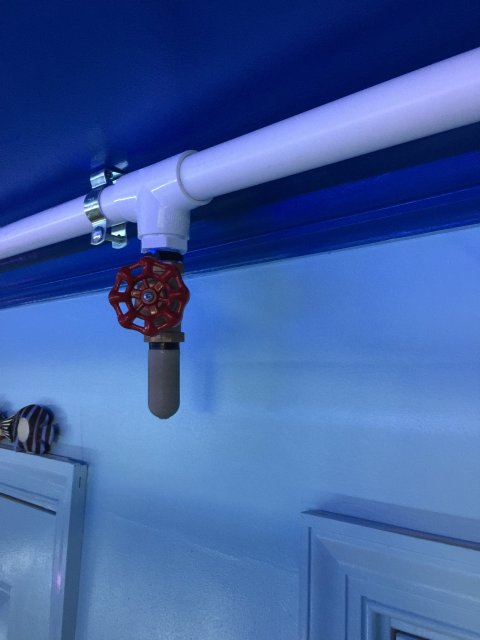Beanie Seagus
Members
Hi All, Sorry to cross post this, but I wasn't sure which forum it best belonged in...
So i'm in the final stages of planning my central air system, i'm going to be ordering the LPH 45 Linear Piston Air Compressor from Jehmco, and creating my own manifold out of pvc and a whole mess of their AV!E air valves.
I have three big questions though that i need answered before i can pull the trigger.
The first is, is there any problem placing the pvc manifold on the ground rather than bolting it to the wall or ceiling? Is this going to cause the manifold to move around due to the air pressure, or worse yet, cause problems for the air attempting to go from the manifold up,5+ feet into my top shelf tanks? I want it on the floor so it remains out of site, my "fish room" is actually my girlfriend and I's living room, and all but two of my tanks are up against a single wall, so i'm not sure there is a need to place the manifold on the wall.
My second question is, another path of least resistance question... for the two tanks that are on the other side of the room, I was thinking i might just use airline tubing to plug them into the manifold. These two tanks are 55 gallons though, that use two airstones each, so we are talking about the use of 8 outlets, each with airline tubing that will need to span about 26ft across the room (not to mention any length of tubing needed to actually reach the sponge filters in the bottom of the tanks). The question is, will this work out ok? I fear that the long distance, plus the number of long distance airlines, plus the fact that these two tanks are my largest and deepest, may cause insufficient air to travel into these sponge filters. What are your thoughts?
My last question is, even assuming the appropriate ammount of sponge filters, as well as extra airstones in each of my 17 tanks, I will still not be running my Linear Piston air compressor at anywhere near its capacity, so i need to know how to "close the pvc manifold air circuit." Do i do this simply by capping both sides of the pvc? Or do i need some kind of air bleeding device? I'm trying to find a cheap solution to this issue, as i'm already sparing no expense with the rest of this airline set up.
Thanks in advance for your help!
So i'm in the final stages of planning my central air system, i'm going to be ordering the LPH 45 Linear Piston Air Compressor from Jehmco, and creating my own manifold out of pvc and a whole mess of their AV!E air valves.
I have three big questions though that i need answered before i can pull the trigger.
The first is, is there any problem placing the pvc manifold on the ground rather than bolting it to the wall or ceiling? Is this going to cause the manifold to move around due to the air pressure, or worse yet, cause problems for the air attempting to go from the manifold up,5+ feet into my top shelf tanks? I want it on the floor so it remains out of site, my "fish room" is actually my girlfriend and I's living room, and all but two of my tanks are up against a single wall, so i'm not sure there is a need to place the manifold on the wall.
My second question is, another path of least resistance question... for the two tanks that are on the other side of the room, I was thinking i might just use airline tubing to plug them into the manifold. These two tanks are 55 gallons though, that use two airstones each, so we are talking about the use of 8 outlets, each with airline tubing that will need to span about 26ft across the room (not to mention any length of tubing needed to actually reach the sponge filters in the bottom of the tanks). The question is, will this work out ok? I fear that the long distance, plus the number of long distance airlines, plus the fact that these two tanks are my largest and deepest, may cause insufficient air to travel into these sponge filters. What are your thoughts?
My last question is, even assuming the appropriate ammount of sponge filters, as well as extra airstones in each of my 17 tanks, I will still not be running my Linear Piston air compressor at anywhere near its capacity, so i need to know how to "close the pvc manifold air circuit." Do i do this simply by capping both sides of the pvc? Or do i need some kind of air bleeding device? I'm trying to find a cheap solution to this issue, as i'm already sparing no expense with the rest of this airline set up.
Thanks in advance for your help!



